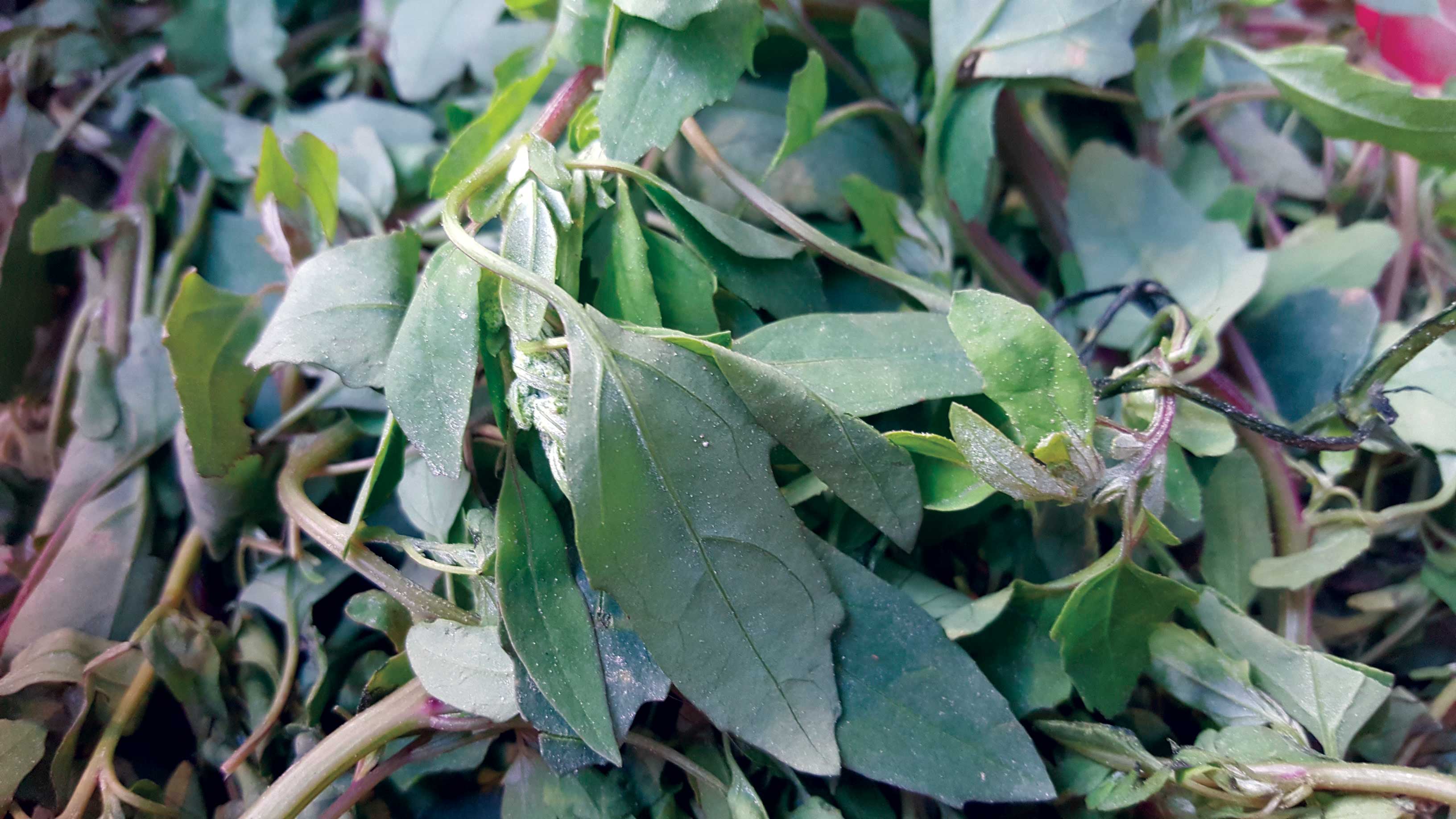West Nepal never fails to capture the imagination of travelers passing through to their trekking destinations. The vibe is chilled, the people are laid-back and the views of the mountains are stunning. Although Baglung and Parbat aren't the most widely known destinations among tourists, they ought to be, as they are historically rich and blessed with pristine natural beauty.
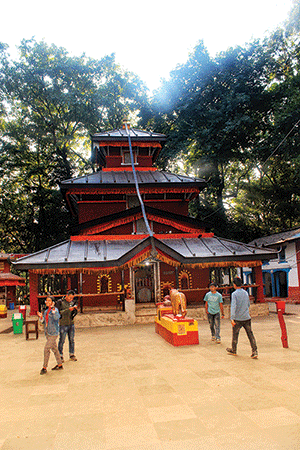
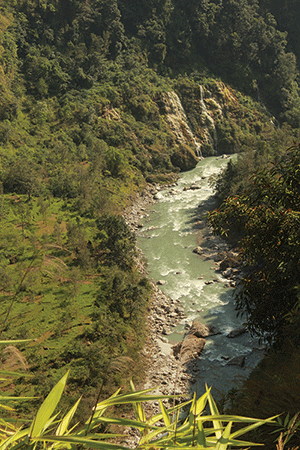
The Baglung Bazaar in the district of Baglung is considered to be the oldest settlement of the Dhaulagiri region. Baglung lies in western Nepal, about 75 kilometers from the popular tourist destination, Pokhara. One can either get a bus from Baglung Bus Park in Pokhara or take a jeep from a place called Zero Kilometers. The journey via Pokhara and the Baglung Highway is full of awe and wonder. You will witness nature at its finest with waterfalls and tiny streams tumbling down the green hills throughout the journey. If the weather is clear, you can see excellent views of snow-capped mountains, too. The vehicles go all the way to Baglung Bazaar but it is best to stop by Kusma Bazaar in Parbart District en route to Baglung. Parbat is known as the home of bridges and as the name suggests, there are a countless number of suspension bridges in the city, as it lies on the banks of the Kali Gandaki and Modi rivers.
The most popular of the bridges are also among the highest and longest suspension bridges in the country: Kushma-Balewa footbridge which connects Kushma and southern region of Baglung, Kushma-Mudikuwa footbridge which lies at a close proximity and has the longest span at 359 meters. The most spectacular of them all is the Kushma-Gyadi footbridge, crossing 117 meters high above the Modi River. It connects Kushma with Gyadichour, located on the other side of the deep Modi River canyon. If you have a fear of heights, like me, you might want to steer clear but when I saw people on motorcycles crossing the bridge, I decided to face my fear because the temptation to see the view from the bridge was irresistible. So I walked at my own pace with assistance from the handrails to witness the magical blue river and green fields below me. For those feeling less adventurous, the bridge has an observation platform that has spectacular views of the Modi River. If you have time, you can also see the one-of-a-kind Kushma Bungee footbridge which is on the verge of completion. Although people will have to wait a while to experience one of the highest bungee jumps in the world, they can try the popular swing nearby, modeled on one in Bali, Indonesia.
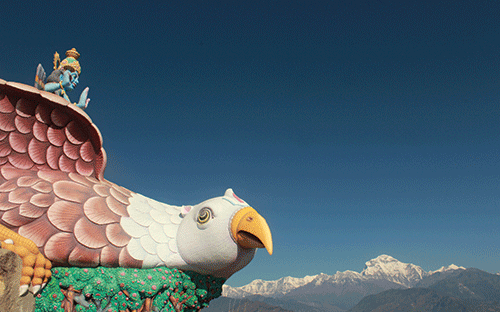
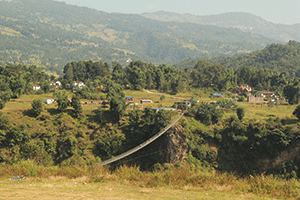
Baglung Bazaar is about 15 kilometers from Kushma Bazaar. One of the most popular places to visit in the region is the Baglung Kalika Bhagwati Temple, which lies about six kilometers from the bazaar, in the middle of a forest. I reached the temple in the early dawn and was welcomed by scented smoke from burning incense and singing of the dozen or so bells leading to the temple complex. Many of the brass bells have been offered by devotees.
Just before you reach the temple complex, you will see nine beautiful miniature stone statues and beneath them, nine stone spouts. Sadly, there’s only a tiny flow of water from them. The multi-roofed temple is surrounded by tall sal trees swaying gently in the breeze, and walking around the area is pleasant and refreshing, especially in the early morning. According to a legend, the King of Parbat, Pratapi Narayan, received an idol of the Goddess Kali (Kalika) as dowry from Palpa's King Manimukunda Sen when he married his daughter in the 1500s. While returning to Parbat from Palpa, the King and the rest of the wedding procession spent the night in the forest. The next morning the idol of the goddess couldn’t be moved so the King decided to built the temple in that very place.
The temple has four doors that face the four cardinal directions, but the eastern door remains closed, as local lore suggests that a cobra appears every time it is opened. There is a small statue of a tiger facing the temple; it is placed there since it is believed that the fearsome goddess rides on it. The temple receives thousands of devotees during festivals, particularly during Dashain, when the Goddess Bhagwati is worshipped.
Another popular tourist destination in Baglung is Panchakot and it was a splendidly cloud-free autumn morning when I woke up very early and set off on the dirt road that leads there. Located at the highest point of Panchakot lies the Panchakot Dham (Pilgrimage). It is eight kilometers uphill from Baglung Bazaar, and can be reached by a 40 minute drive from there. The brain child of a Hindu Sage, Swami Kamalnayana Acharya, also known as Muktinath Baba, Panchakot Dham was originally called Sarbasiddhi Dham. The pilgrimage got its name Pancha (Five), Kot (places) by merging five different religious places: Karikot, Majhkot, Raynaraynakot, Sansaarkot and Tarajalkot.
The road winds up the hill from where colorful paddy terrace fields, village homes and mountains can be marveled at. The trip can be made by a four-wheel drive vehicle only to the end of the Panchakot Village road, after which you will be greeted by a long set of steps to reach the temple top. Those who have bikes can go all the way via an alternative off road route.
The trail is covered by green forest, creating shade from the direct sunlight. It’s a not a very long walk and not especially difficult but you might get a little tired as the concrete staircase is replaced by large unstable stone steps just before reaching the top. But you can pause whenever you want to enjoy the panorama, and remind yourself that the view from the top makes it all worthwhile. As you make your way up the hill, the exquisite view of Dhaulagiri mountain range in the distance appears closer and closer. The mountain, one of the 14 mountains that stand more than 8,000 metres tall, does justice to its name; Dhawala (dazzling), giri (mountain).
I finally reached the top, weary and sore-footed. The first thing I noticed when I reached the temple complex was colorful shrines with figures depicting different gods. The most impressive among them is a statue of Lord Vishnu sitting on top of Garuda, the king of birds and the carrier of Lord Vishnu, according to Hindu texts. If you look at the statue from a distance, it looks like the god is flying over the mountains on a bird whose wings cover the sky. If you are lucky, you will also see part of the Annapurna range, with its peaks ranging from 6,000 to over 8,000 meters.
One can enter the Sish Mahal,or Mirror Palace, by paying an entrance fee. It is a structure completely clad in multi-colored mirrors with a statue of Lord Krishna and Radha. The giant Kalash (copper prayer pot) is very remarkable too but nothing compared to the proposed 135 ft pot under construction.
After you climb to the highest point on the hill, you will see the imposing statue of Lord Hanuman (God of strength) carrying the Sanjeevani Mountain with the dramatic view of the mountains in the background. As the Ramayana (Hindu epic) legend goes, Lord Hanuman arrived in the Himalayas to retrieve Sanjeevani, a life-saving herb, to save Lord Rama's brother Laxman, but since he could not identify it, he lifted the entire mountain and carried it to Lanka (Sri Lanka). I often ask myself why most temples are located on top of hills, surrounded by mountains or in the middle of the forest? But I guess one can only be liberated if you get away from the distractions of the world you live in.
Beside the giant statue of Hanuman there is a framed structure that is the proposed location for a 5000 kilogram bell. Other attractions of the place include the Ganesha and Gandaki Temples, named after the Kali Gandaki River. Panchakot is fast becoming a popular religious tourism site in Western Nepal and the sage would like to connect the site with Muktinath Temple in Mustang.
Baglung has a lot more to offer. You can take a jeep ride off-road to experience the beautiful Gaighat waterfall in Galkot or trek to the magnificent Dhorpatan Hunting Reserve, the only one of its kind in the country. The reserve adjoins Baglung, Myagdi and Rukum Districts and is home to the Himalayan tahr and blue sheep. You can reach the reserve via Burtibang.
Looking back on my journey, I learnt that sometimes you need to take the road less traveled instead of a well beaten path. You need to keep moving until the unpleasant noise of the cities begins to fade out and you are engulfed in the sound of spirituality, and silence of the hills, to truly discover yourself.
Gokarna Forest Resort The Royal Hunting Ground
As you drive along the winding roads that lead you to the gates to Gokarna Forest Resort, its hard to...




